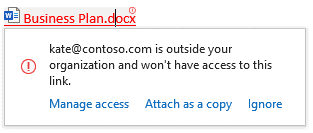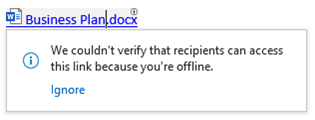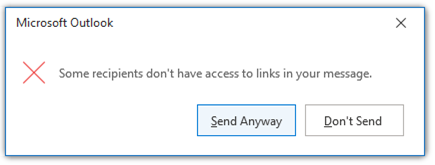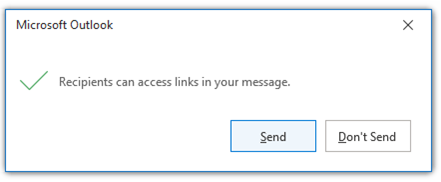If you have links in the body of your email messages that point to files stored on OneDrive or SharePoint, Outlook displays several types of information about these links and allows you to control who can access the linked files.
How do I know which links point to files stored on OneDrive or SharePoint?
When you add a link to a file on OneDrive or SharePoint in the body of your email message, Outlook displays that link with a gray background. If you click the link, you'll see a small dialog box that lets you know who will be able to access the link.
Note: The information here applies to links inserted in the body of an email message only. Even though you can attach files directly to the email message from OneDrive or SharePoint and control the permissions on those files in a similar way, the information in this topic applies only to links inserted into the body of your email message.
How do I insert a link to a OneDrive or SharePoint file?
There are several ways you can insert a link in the body of your email message.
-
Copy the link from OneDrive or SharePoint, then paste it into the message body.
-
With a new email message, reply, or forward open, select Message > Link > Insert Link. Then select a file stored on OneDrive or SharePoint.
-
Reply to or forward a message with existing links.
Outlook will automatically set the permissions on the link to whatever your tenant admin has chosen as the default permission for your organization.
How do I change permissions on my link?
If you want to change who can access your link to a OneDrive or SharePoint document, click the link in the body of the email message, then select the > symbol on the permissions dialog box to display the link settings.
Select or click any of the listed options.
In addition to choosing an access level, you can also allow editing (or uncheck the box to disable editing) and even block downloading. In this case, the file linked to will open in a browser window only.
Note: In order to block downloading of a file, you must uncheck the Allow editing option.
Select Apply to save your changes. You can set separate permission levels for each link you add to the body of your email message.
Will my recipients have access to the linked file?
Outlook checks to see if your message recipients will be able to access the links you have in your message to files stored on OneDrive or SharePoint. This process happens quickly, but can take additional time if you're sending a message to a large number of recipients. You can't send your message until Outlook completes this check.
If Outlook confirms that one or more recipients won't be able to access your link, the link will change color to red, and a small red exclamation mark will appear next to the link's name. If you click the link, you'll see information about which recipients can't access your link and why.
From the pop-up, you'll be able to Manage access and change the link's access level, choose to attach the file as a copy rather than a link, or ignore the warning.
Tip: If you have multiple links in your email message with access errors, you can navigate between the links with errors by using the keyboard shortcut Ctrl+Alt+F1.
If Outlook can't verify if your recipients have access to the link, you'll see a small exclamation mark next to the link name, but the link won't change color. Clicking the link will let you choose to ignore this notice.
Before you send your message, Outlook will warn you if some of your recipients don't have access to one or more links. You can Send Anyway or choose Don't Send to revisit the link access permissions.
Sending your message
If you try to send your email message before Outlook has finished checking to see if all recipients can access the links in y our message, you'll see a warning message. You can Send Anyway or Don't Send and allow Outlook to finish checking permissions. If you do nothing, the warning message will change as soon as Outlook has finished checking your links.
















